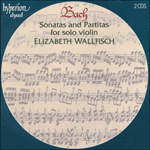The third work in Bach’s collection is the Sonata in A minor (BWV1003). In its opening Grave, a Largo to all intents and purposes, Bach makes extensive use of multiple stopping to provide harmonic support to the melodic line. As in the slow movement of the G minor Sonata, the music contains structural ambiguities for performer and listener alike, providing players with a variety of interpretative possibilities. The Fuga which follows presents a terse subject which, however, Bach develops in a manner altogether more complex than the equivalent movement in the G minor work. Here he achieves a wonderful expressive variety, developing the fugal material with contrasting passages of semiquavers, and multiple stopping to create two or three independent parts. The melodic line of the lyrical Andante is strongly differentiated from the underlying harmonic support, presenting something of a challenge to the performer who must preserve the distinction between the two elements. This melodically appealing movement leads to an Allegro finale, in binary form, in which Bach dispenses with multiple stopping in favour of a single melodic line containing a profusion of broken chords. The Sonata was later transcribed, perhaps by Wilhelm Friedemann Bach, as a piece for harpsichord solo (BWV964).
from notes by Nicholas Anderson © 2009
La troisième œuvre du recueil de Bach est la Sonate en la mineur (BWV1003). Dans son Grave initial, quasiment un Largo, Bach fait un usage intensif des accords sur plusieurs cordes pour fournir un soutien harmonique à la ligne mélodique. Comme dans le mouvement lent de la Sonate en sol mineur, la musique contient des ambiguïtés structurelles pour l’interprète comme pour l’auditeur, ce qui offre aux instrumentistes des possibilités d’interprétation très variées. La Fuga qui suit comporte un sujet laconique que Bach développe toutefois d’une manière plus complexe que le mouvement homologue dans l’œuvre en sol mineur. Ici, il parvient à une merveilleuse variété d’expression, développant le matériel fugué avec des passages contrastés en doubles croches et sur plusieurs cordes pour créer deux ou trois parties indépendantes. La ligne mélodique de l’Andante lyrique est fortement différenciée du support harmonique sous-jacent, ce qui constitue un défi pour l’interprète afin que les deux éléments restent bien distincts. Ce mouvement séduisant sur le plan mélodique mène à un Allegro final, de forme binaire, où Bach se passe des cordes multiples en faveur d’une seule ligne mélodique contenant une profusion d’accords arpégés. Cette Sonate a été ensuite transcrite pour clavecin seul (BWV964), peut-être par Wilhelm Friedemann Bach.
extrait des notes rédigées par Nicholas Anderson © 2009
Français: Marie-Stella Pâris
Das dritte Werk in Bachs Zyklus ist die Sonate in a-Moll (BWV 1003). Im ersten Satz, Grave (das sich wie ein Largo verhält), verlangt Bach mehrmals Doppelgriffe und Akkorde, um der Melodielinie genügend harmonische Unterstützung zu liefern. Ebenso wie in dem langsamen Satz der g-Moll Sonate werden auch hier dem Ausführenden und dem Hörer gleichermaßen strukturelle Mehrdeutigkeiten zugemutet, was den Musikern verschiedene Interpretationsmöglichkeiten bietet. Die darauffolgende Fuga stellt ein prägnantes Thema vor, das Bach jedoch in komplexerer Weise verarbeitet als in dem entsprechenden Satz der g-Moll Sonate. Hier gelingt ihm eine wunderbare expressive Vielfalt, wobei er das Fugenmaterial mit kontrastierenden Sechzehntelpassagen verarbeitet und durch Mehrfachgriffe eine Zwei- bzw. Dreistimmigkeit erzeugt. Die Melodielinie des lyrischen Andante unterscheidet sich deutlich von dem darunterliegenden harmonischen Gerüst, was für den Interpreten eine Herausforderung darstellt, da er den Unterschied zwischen den beiden Elementen herausarbeiten muss. Dieser melodisch schöne Satz führt zum Schlusssatz, Allegro, hinüber, der zweiteilig angelegt ist. Bach gibt hier die Doppel- bzw. Mehrfachgriffe zugunsten einer einzelnen Melodielinie auf, die eine Reihe von gebrochenen Akkorden aufweist. Diese Sonate wurde später, möglicherweise von Wilhelm Friedemann Bach, für Cembalo solo transkribiert (BWV 964).
aus dem Begleittext von Nicholas Anderson © 2009
Deutsch: Viola Scheffel


 Bach: Sonatas and Partitas for solo violin
Bach: Sonatas and Partitas for solo violin
